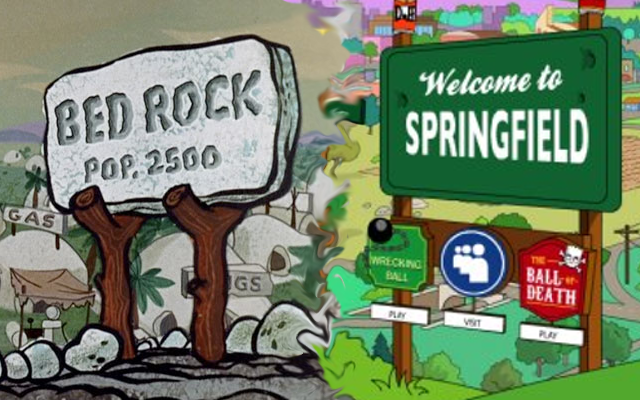From Bedrock to Springfield: The History of Prime-Time Cartoons for Adults

As anyone who has ever animated will tell you: cartoons are not merely kid’s stuff. The process of animating is tedious beyond tedium. We take it for granted now that animated features frequently play in major theaters, but Disney was the laughing stock of Hollywood during the three years that his production company spent developing Snow White and The Seven Dwarfs. After the film came out, and it was Disney who enjoyed the last laugh.
But when it came to animating for television, production companies couldn’t take three years to get a project going. Television demanded a different production model, one that favored expedience, and placed more emphasis on the writing and repartee between characters than it did on the sleekness of the animation itself.
When animation purists complain about programs like The Simpsons for relying too heavily upon stock character expressions and simplistic animation, they fail to realize that Matt Groening and company are working within the parameters of a studio system established in the 1950’s.
One of the true pioneers of limited animation television programming was producer Jay Ward. Ward, and animator Alex Anderson, pioneered methods of “limited animation.” To briefly explain what this means: traditional animation (such as the classic Disney shorts) would be animated at 24 frames a second. In some instances, this would mean that a second of footage was comprised of 24 unique images. With limited animation, there are about half as many drawings, and there are several other technical shortcuts employed. For example, letting the dialogue drives the narrative. One of the first limited animation programs that Jay Ward sold was called Crusader Rabbit, and it aired on various NBC affiliates from 1948 to 1951. The show was crucial in establishing the foundation of TV animation, but it has not aged well.
Ward and Anderson broke new ground with the program The Rocky and Bullwinkle Show, which aired from 1959 to 1961 on ABC, and 1961 to 1964 on NBC. Writer Bill Scott was recruited to assist with scripts, and the program became a smash success. The program was structured like a variety TV show, with disparate narratives strung together with animated interstitials such as “Fractured Fairy Tales” segments which parodied Grimm fairy tales, or the Mr. Peabody segments, which featured a precocious pooch who traveled through time and rewrote history. The dialogue was sharply written, and, unlike Crusader Rabbit, the program has aged quite well. Although it was aimed primarily at a young audience, topical jokes and allusions made the show appealing to adults.
The real trendsetter, however, was the first prime-time animated program aimed at kids and adults: The Flintstones, which ran from 1960 to 1966 on ABC. The program was the brainchild of William Hanna and Joseph Barbera, who essentially took the central characters from the classic sitcom The Honeymooners, and placed them in prehistoric times. The show is remembered for its primitive answers to (what were at the time) contemporary technologies, with small critters or dinosaurs typically serving as everyday appliances. They were, as the title song says, a “modern stone-age family.” For all its cutesy characteristics, the show didn’t shy away from heavier themes. One episode dealt with infertility issues (Betty Rubble is distressed that she can’t conceive, and the Rubbles ultimately adopt Bam-Bam).
Many people had been skeptical about the viability of cartoons on prime-time TV. The Flintstones effectively demonstrated that, with clever writing and topical relevance, it could be done. There were, however, a few shows that attempted to follow in the footsteps of The Flintstones that didn’t quite make the cut.
One such program was Wait Till Your Father Gets Home, which ran in syndication from 1972 to 1974. The idea for the program was conceived by Hanna Barbera writers Ray Allen and Harvey Bullock, who had previously worked on The Flintstones. The had this idea for making an animated program that was more overtly for adults. It revolved around a balding, conservative father, a patient mother, a pudgy, intellectual feminist teenage daughter, and a long-haired son who could never hold a job and was living at home indefinitely. While largely obscure now, this show, more than any other, established the blueprint for programs like The Simpsons and Family Guy.
The Simpsons family, of course, started out as an animated segment on the “The Tracey Ullman Show.” The popularity of the animated segments soon eclipsed the popularity of the rest of the show, and the series premiere was the “Simpsons Roasting on an Open Fire” Christmas special which first aired in 1989. It seemed like an advantageous premiere date, in that there were precedents set for prime-time animated programs broadcast during the holiday seasons (such as How the Grinch Stole Christmas or the Rankin Bass Rudolph the Red-Nosed Reindeer).
And now with the show entering into its 26th season, just shortly after an FXX 12 Day marathon underway (so popular that Direct TV offered subscribers a free trial during the marathon), The Simpsons is now just part of a market that has become, in recent years, oversaturated with shows that lack nuance, and favor over-the-top crudeness in their site gags. Some producers have managed to follow suit of The Simpsons, including the phenomenally talented Mike Judge, and the talented team of Trey Parker and Matt Stone, while others have been critical of Seth MacFarlane for a reliance on tired formulas and conceptually undercooked narratives.
What has always distinguished programs like The Simpsons, and what we will hopefully see more of in years to come, is animated programming that is thoughtful, conscious of social issues, and well written.
Read more comedy news, stories, interviews with comedians, videos and comedy clips on our home page. Get more comedy news. Watch more viral videos. Read more interviews with the best comics in the business.
.
Latest posts by Kate Voss (see all)
- I’m a Loner Dottie, A Rebel: Looking Back at Pee-wee’s Influence on Cinema in Anticipation of His Upcoming Netflix Project - April 15, 2015
- Equitable Ectoplasm? The New All-Female Ghostbusters Sure to Generate Money, and Likely to Disappoint Feminists - February 25, 2015
- From Bedrock to Springfield: The History of Prime-Time Cartoons for Adults - September 28, 2014
